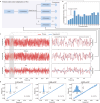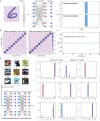Integrated lithium niobate photonic computing circuit based on efficient and high-speed electro-optic conversion
- PMID: 40890103
- PMCID: PMC12402124
- DOI: 10.1038/s41467-025-62635-8
Integrated lithium niobate photonic computing circuit based on efficient and high-speed electro-optic conversion
Abstract
The surge in artificial intelligence applications calls for scalable, high-speed, and low-energy computation methods. Computing with photons is promising due to the intrinsic parallelism, high bandwidth, and low latency of photons. However, current photonic computing architectures are limited by the speed and energy consumption associated with electronic-to-optical data transfer, i.e., electro-optic conversion. Here, we demonstrate a thin-film lithium niobate (TFLN) computing circuit that addresses this challenge, leveraging both highly efficient electro-optic modulation and the spatial scalability of TFLN photonics. Our circuit is capable of computing at 43.8 GOPS/channel while consuming 0.0576 pJ/OP, and we demonstrate various inference tasks with high accuracy, including the classification of binary data and complex images. Heightening the integration level, we show another TFLN computing circuit that is combined with a hybrid-integrated distributed-feedback laser and heterogeneous-integrated modified uni-traveling carrier photodiode. Our results show that the TFLN photonic platform holds promise to complement silicon photonics and diffractive optics for photonic computing, with extensions to ultrafast signal processing and ranging.
© 2025. The Author(s).
Conflict of interest statement
Competing interests: L.H., Y.W., K.L., M.Z., and M.L. are involved in developing lithium niobate technologies at HyperLight Corporation. The remaining authors declare no competing interests.
Figures






References
-
- Yao, P. et al. Fully hardware-implemented memristor convolutional neural network. Nature577, 641–646 (2020). - PubMed
-
- Shen, Y. et al. Deep learning with coherent nanophotonic circuits. Nat. Photonics11, 441–446 (2017).
-
- Lin, X. et al. All-optical machine learning using diffractive deep neural networks. Science361, 1004–1008 (2018). - PubMed
Grants and funding
- HR0011-20-C-0137/United States Department of Defense | Defense Advanced Research Projects Agency (DARPA)
- OMA-2137723/National Science Foundation (NSF)
- N00014-22-C-1041/United States Department of Defense | United States Navy | ONR | Office of Naval Research Global (ONR Global)
- 231180A/80NSSC22K0262/National Aeronautics and Space Administration (NASA)
- NRF2022-QEP2-01-P07/National Research Foundation Singapore (National Research Foundation-Prime Minister's office, Republic of Singapore)
LinkOut - more resources
Full Text Sources
Miscellaneous

